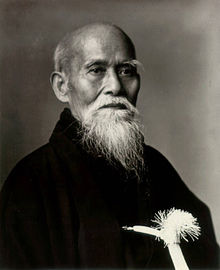The Relevance of Giants – 2. O Sensei (Morihei Ueshiba)
The Relevance of Giants – 2. O Sensei (Morihei Ueshiba)
On most every occasion when I’m speaking in public – at conferences, workshops, and the like – I tend to mention one or more of my “Giants” of Rightshifting. Men and women who, through their lives and work have contributed significantly to my understanding of work, and in particular to my understanding of effective collaborative knowledge work.
Many folks express interest in these Giants, but I do wonder if they appreciate the relevance of the ideas and experiences of these Giants to their own daily lives at work.
I mean, what relevance does, say, O Sensei have to developers, testers, operations staff and the like? Which aspects of any of these Giants’ work could be useful or helpful or simply comforting to these folks?
In this occasional series of posts I’ll be exploring some of the Giants’ relevance to folks other than theorists, managers, consultants and the like. I’ll be sharing some insights into their work, and specifically, the likely relevance.
With these posts I hope to pique your curiosity just a little. Let’s continue, with this second post in the series, with O Sensei.
O Sensei
(December 14, 1883 – April 26, 1969) (See also: Wikipedia entry)
I’m not going to dwell on his early life and experiences in the Japanese Army, his adventures in Mongolia, nor his experiences in Manchuria and Japan during the time of World War 2.
Aikido
I suggest the primary relevance of O Sensei to most folks working in the field of software development (and production operations) is Aikido – the martial art he developed. Excepting it’s less a martial art, and more a philosophy for life, and for harmonising with others.
Unlike many other martial arts, Aikido is focussed on caring for others, as emphasised by the translation of the three kanji: ai-ki-do as the Way of Unifying Spirit or the Way of Spiritual Harmony. O Sensei envisioned Aikido as an expression of his personal philosophy of universal peace and reconciliation. O Sensei’s goal was to create an art that practitioners could use to defend themselves while also protecting their attacker from injury.
“Blending“, one of the core techniques of Aikido, invites us to look at conflicts from the perspectives of the other person – or people – involved. For me, this has a direct connection with empathy – as promoted by e.g. Marshall Rosenberg and others of the nonviolent community.
“Life is growth. If we stop growing, technically and spiritually, we are as good as dead.”
~ Morihei Ueshiba
Where’s the Relevance?
How do we make it more likely that we’re all spending our time on stuff that matters? How do we go about attending to folks’ real needs? I find blending a great asset in identifying with the needs of others. As I blend, I see their perspective, and their needs, more clearly. And in turn, they can feel more listened-to. And choose to reveal other things, crucial things, that means we get to understand more about what matters to us all. With this knowledge – and goodwill – we have a better chance of focusing on what matters, and of reducing the chance of wasting some or all of our time on the inconsequential, on detours, and on dead ends.
Practical Investigation
You might like to join an Aikido dojo, to practice the physical forms of the techniques. And to discuss the philosophy with like-minded people wha have already started the journey. Beware, though, of those dojos and sensei that emphasise the physical forms at the expense of Aikido philosophy.
– Bob
Further Reading
The Life We Are Given ~ Michael Murphy, George Leonard
The Way of Aikido ~ George Leonard
It’s A Lot Like Dancing ~ Terry Dobson


The practice of Aikido is extremely relevant indeed for the art of product development, even out of the scope of rightshifting or agility. I often suggest to the people I coach (product owners, scrum masters, project managers) to try aikido. It is a philosophy and it is a practice. Practicing aikido, you get trained to pay attention to the context, to make unity with the context (the guy that is attacking you for instance), without submitting to the context (you don’t let the attacker kill you) – maybe that’s what you call blending. I call it dismantling the intention and the movement: you go with the imposed movement and you have your own intention and then you transform the movement according to your intention. It is a very powerful pattern for “change management”.
Thanks for responding. 🙂 I concur.
PS. “Blending” is the term widely used in the Aikido community.
Probably, but I practiced Aikido in the French language!